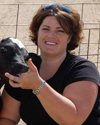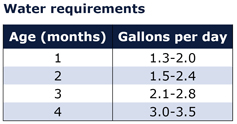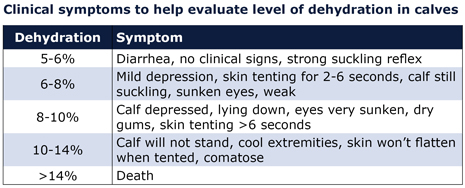
Are you catching and treating dehydration soon enough?
 By Ann Hoskins Recognizing and treating dehydration is key to raising healthy calves. Calves will become dehydrated for many reasons, including summer heat and scours. If you can catch dehydration early, supplemental fluids can get the calf on the road to a quicker recovery. A calf’s body contains 75 to 80 percent water at birth and about 55 to 60 percent at maturity. So understandably, water consumption is important during periods of dehydration. When dehydrated, calves will try to replace fluids by drinking a total of 3 to 6 gallons of water per day, which includes their normal milk replacer feedings.
By Ann Hoskins Recognizing and treating dehydration is key to raising healthy calves. Calves will become dehydrated for many reasons, including summer heat and scours. If you can catch dehydration early, supplemental fluids can get the calf on the road to a quicker recovery. A calf’s body contains 75 to 80 percent water at birth and about 55 to 60 percent at maturity. So understandably, water consumption is important during periods of dehydration. When dehydrated, calves will try to replace fluids by drinking a total of 3 to 6 gallons of water per day, which includes their normal milk replacer feedings.  Penn State Extension Circular 387 Early signs of dehydration can sometimes be hard to recognize. Calves can lose up to 6 percent of their bodyweight in fluids before symptoms of dehydration are recognized. While severe dehydration is not hard to detect (sunken eyes, ears are cold, tenting of the skin, calf is depressed or not standing), early signs may go unnoticed. Early signs include:
Penn State Extension Circular 387 Early signs of dehydration can sometimes be hard to recognize. Calves can lose up to 6 percent of their bodyweight in fluids before symptoms of dehydration are recognized. While severe dehydration is not hard to detect (sunken eyes, ears are cold, tenting of the skin, calf is depressed or not standing), early signs may go unnoticed. Early signs include:
- Lack of appetite
- Drinking milk slower than usual or not finishing her milk
- Any changes in behavior are often a sign of distress
 Adapted from J.M. Naylor, Can. Vet. J. (1989) Scours or diarrhea is usually a good prediction of a dehydration problem. Watching the manure consistency is a normal check for most calf raisers; relating that to dehydration can help in the prevention. If the manure piles, dehydration is usually not a concern. If the manure puddles, watch the calf closely as mild dehydration is likely. If the manure is fluid, dehydration is almost certain. Free choice water should always be available to calves, but becomes much more critical in cases of dehydration. Supplemental fluids such as electrolytes should be given to calves when manure looks like a puddle or fluid. Electrolyte products are combinations of minerals, carbohydrates (sugars), and amino acids that assist in rehydrating the calf, replace lost minerals, and provide energy and protein for the calf. Electrolytes are not intended to be used as a treatment for scours, but as a supplemental fluid to rehydrate the calf. Milk or milk replacer feedings should continue as usual. Calves need the nutrients provided in the milk diet to support maintenance and growth. Very few electrolytes contain enough calories to support the calf. Calves fed milk along with supplemental fluids will recover more quickly. Overfeeding electrolytes causes little harm, but in some cases it may prolong scouring. Determine the amount of electrolytes needed by multiplying the weight of the calf by the percent dehydration and then divide by 100. This will give you the pounds the calf needs to drink in addition to its milk or milk replacer feeding. Then divide by 2 to get the quarts of liquid needed. Electrolytes should be fed several hours after feeding milk. Ingredients in electrolytes may impair the formation of the casein clot in the abomasum, therefore reducing digestibility. If the milk is fed in the early morning and afternoon, noon would be a good time to add an electrolyte feeding to the calf program. If necessary, add an additional electrolyte feeding in the afternoon, but wait at least two hours after the milk has been fed. Remember, early detection of dehydration leads to quicker treatment and getting your calves back on the right track as soon as possible. This article was originally shared in the August 2011 edition of Starting Strong. Vita Plus Starting Strong is a free, bi-monthly calf care e-newsletter. Click here to subscribe and receive practical tips and cutting edge research straight to your inbox. About the author: Ann Hoskins is the Vita Plus calf products manager. She grew up on a dairy farm in DeForest, Wis., which she says is instrumental to where she is today. “The lessons and values I gained growing up in this industry have given me the passion to stay involved and continue to learn more every day.” Hoskins earned her bachelor’s degree from the University of Wisconsin-Madison and has spent that last five years at Vita Plus, working with producers to improve performance and help them reach the goals of their calf operations.
Adapted from J.M. Naylor, Can. Vet. J. (1989) Scours or diarrhea is usually a good prediction of a dehydration problem. Watching the manure consistency is a normal check for most calf raisers; relating that to dehydration can help in the prevention. If the manure piles, dehydration is usually not a concern. If the manure puddles, watch the calf closely as mild dehydration is likely. If the manure is fluid, dehydration is almost certain. Free choice water should always be available to calves, but becomes much more critical in cases of dehydration. Supplemental fluids such as electrolytes should be given to calves when manure looks like a puddle or fluid. Electrolyte products are combinations of minerals, carbohydrates (sugars), and amino acids that assist in rehydrating the calf, replace lost minerals, and provide energy and protein for the calf. Electrolytes are not intended to be used as a treatment for scours, but as a supplemental fluid to rehydrate the calf. Milk or milk replacer feedings should continue as usual. Calves need the nutrients provided in the milk diet to support maintenance and growth. Very few electrolytes contain enough calories to support the calf. Calves fed milk along with supplemental fluids will recover more quickly. Overfeeding electrolytes causes little harm, but in some cases it may prolong scouring. Determine the amount of electrolytes needed by multiplying the weight of the calf by the percent dehydration and then divide by 100. This will give you the pounds the calf needs to drink in addition to its milk or milk replacer feeding. Then divide by 2 to get the quarts of liquid needed. Electrolytes should be fed several hours after feeding milk. Ingredients in electrolytes may impair the formation of the casein clot in the abomasum, therefore reducing digestibility. If the milk is fed in the early morning and afternoon, noon would be a good time to add an electrolyte feeding to the calf program. If necessary, add an additional electrolyte feeding in the afternoon, but wait at least two hours after the milk has been fed. Remember, early detection of dehydration leads to quicker treatment and getting your calves back on the right track as soon as possible. This article was originally shared in the August 2011 edition of Starting Strong. Vita Plus Starting Strong is a free, bi-monthly calf care e-newsletter. Click here to subscribe and receive practical tips and cutting edge research straight to your inbox. About the author: Ann Hoskins is the Vita Plus calf products manager. She grew up on a dairy farm in DeForest, Wis., which she says is instrumental to where she is today. “The lessons and values I gained growing up in this industry have given me the passion to stay involved and continue to learn more every day.” Hoskins earned her bachelor’s degree from the University of Wisconsin-Madison and has spent that last five years at Vita Plus, working with producers to improve performance and help them reach the goals of their calf operations.
| Category: |
Animal health Dairy Performance |

